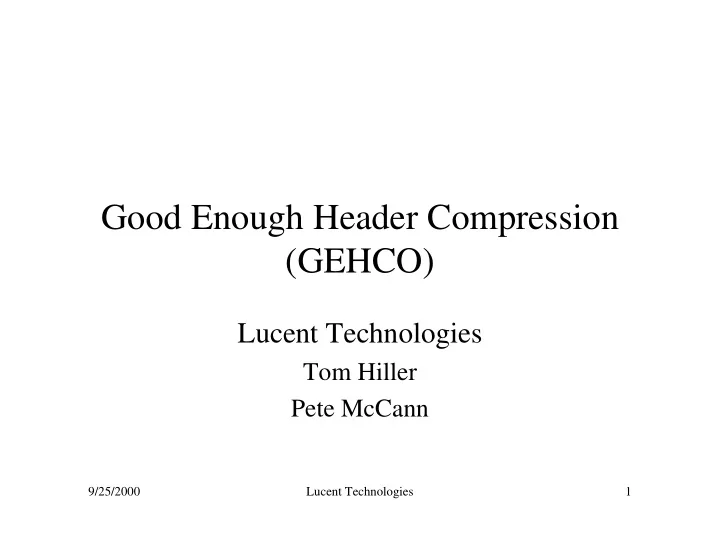

Good Enough Header Compression (GEHCO) Lucent Technologies Tom Hiller Pete McCann 9/25/2000 Lucent Technologies 1
Motivation • 3GPP2 plans to support VOIP and multimedia directly to the mobile to provide new services – allows mobiles to use of SIP based browsers and land line VOIP/multimedia servers • Size and frequency of RTP packets forces use of IP/UDP/RTP packet header compression 9/25/2000 Lucent Technologies 2
Categories of Header Compression • Transparent : The IP/UDP/RTP header reconstructed by the decompressor matches the original IP/UDP/RTP sent packet bit for bit. • Non-Transparent : The IP/UDP/RTP header reconstructed by the decompressor does not exactly match the original IP/UDP/RTP sent packet bit for bit. Some fields such as RTP sequence counts, time-stamps, and UDP CRC may be altered from an end to end point of view. 9/25/2000 Lucent Technologies 3
Transparent Compression • Existing working group draft • 3GPP2 example:1 byte of IP/UDP/RTP, 2 bytes for PPP, using variable rate vocoder (see draft for rates) – Reduced spectral capacity • 40% loss (synchronous to 20ms frames) • 16% loss (asynchronous to 20ms frames) – Another example: 1 byte and no PPP bytes: 13% loss • Bottom line: – 3PGG2 will support transparent compression for those that need it and can pay for it – Unacceptable to 3GPP2 carriers for wide spread use 9/25/2000 Lucent Technologies 4
Header Stripping and Regeneration • Send 20ms vocoder frames without headers – Maximizes spectral efficiency • Methods – Gateway – Non transparent compression • Native wireless signaling • Link (PPP) level compression 9/25/2000 Lucent Technologies 5
Gateway Approach • Mobile sets up a circuit path to gateway – The gateway is between the wireless link and the FA – Mobile and gateway agree on an over-the-air circuit connection – Gateway wraps vocoder data in IP/UDP/RTP header, using the gateway address as source address • Problem – Does not work well with Mobile IP because IP/UDP/RTP packets have gateway address 9/25/2000 Lucent Technologies 6
Non Transparent Compression • Need to send full header context information and associated circuit identifier from compressor to decompressor – Radio specific signaling – PPP 9/25/2000 Lucent Technologies 7
Data Link • Extend PPP to – carry full header information with – identify an over-the-air connection that carries “headerless” vocoded data • Decompressor wraps vocoder data in IP/UDP/RTP headers 9/25/2000 Lucent Technologies 8
Good Enough Header Compression • General idea – Compress: Remove the IP/UDP/RTP header and transmit only the IP/UDP/RTP payload – Decompress: Wrap the received payload in a IP/UDP/RTP header – Use physical framing, not PPP/HDLC for RTP payload • Result: Same spectral capacity as circuit voice • IPR statement: There is no IPR 9/25/2000 Lucent Technologies 9
Link Assumptions • The physical frame carries one vocoder frame, exactly • The decompressor is able to determine the size of the vocoded data from the frame • The frame rate is precisely known (e.g. 20ms) • Mobile and network can share an identifier to can identify an over-the-air connection that will carry the vocoder data 9/25/2000 Lucent Technologies 10
Link Assumptions (contd) • Two over-the-air connections – voice connection for vocoded voice • no retransmission for minimal latency • no IP or PPP headers • called the “vocoder connection” in the draft – data connection for TCP like data • retransmission for better effective error rate • carries IP and PPP headers • called the “PPP connection” in the draft 9/25/2000 Lucent Technologies 11
Operation • Mobile establishes PPP, negotiates GEHCO, establishes vocoder over the air connection • New RTP flow arrives at PPP layer entity • The PPP entity stores src/dest address/ports and RTP sequence number in a table • Compressor sends GEHCO_FULL_HEADER packet to decompressor • Commences to send payload on over-the-air connection 9/25/2000 Lucent Technologies 12
Operation (continued) • GEHCO_FULL_HEADER has – IP addresses – UDP ports – RTP sequence number – Connection ID (CID) = over-the-air connection ID • Decompressor uses GEHCO_FULL_HEADER to create a new table entry • Decompressor sends GEHCO_ACK to compressor 9/25/2000 Lucent Technologies 13
Decompression • Extracts payload from over-the-air connection • Creates time stamps and sequence numbers – time stamps created by counting physical frame intervals (e.g. 20ms intervals) • Erred vocoder frames: Decompressor increments sequence counter – Allows RTP correspondent node to notice frames are missing and possibly mask the error/loss – Buffer data to prevent under-run due to IP jitter 9/25/2000 Lucent Technologies 14
Conclusion • 3GPP2 will support IETF transparent compression, but needs a non transparent approach consistent with PPP • GEHCO is a starting point – PPP provides for negotiation and context exchange – GEHCO defines PPP signaling for negotiating any of the other RTP compression formats – IPR statement: There is no IPR • Can we make GEHCO a working group item? 9/25/2000 Lucent Technologies 15
Recommend
More recommend